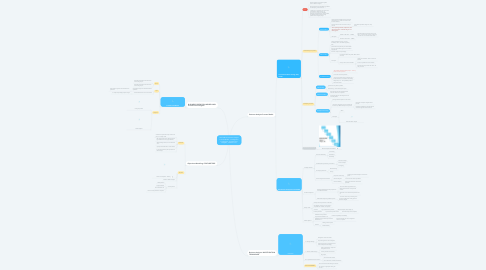
1. Business Analysis Process Model
1.1. A Creative Problem Solving (CPS) model
1.1.1. WHY?
1.1.1.1. BAs are supposed to provide thoughtful solution ideas to managers
1.1.1.2. Need a framework for understanding problems and developing creative solutions
1.1.1.3. it guides you in using both your creative and critical thinking skills in harmony, on your own or in a group, to understand challenges and opportunities, generate ideas, and develop effective plans for solving problems and managing change
1.1.2. Understanding the problem
1.1.2.1. Mess finding
1.1.2.1.1. identify and acknowledge what’s the mess that needs cleaning up, which is the situation that demands attention.
1.1.2.1.2. knowing where to start if ever there is really a need to
1.1.2.1.3. we are probing interests, experiences, and personal concerns – and that will give us a starting point.
1.1.2.1.4. techniques:
1.1.2.2. Data finding
1.1.2.2.1. collect information (opinions, concerns, knowledge, ideas…) and obtain supporting data
1.1.2.2.2. present the findings from all your collected data and may include tables, figures, text or all three if appropriate.
1.1.2.2.3. Interview, surveys, activity sampling…
1.1.2.2.4. techniques:
1.1.2.3. Problem finding
1.1.2.3.1. "No Problem statement, NO project" - said my master course supervisor
1.1.2.3.2. uncover the heart of the problem
1.1.2.3.3. convert a fuzzy statement of the problem into a broad statement more suitable for idea finding
1.1.2.3.4. asking ‘Why?’ etc. – the repeatable questions and Five W's and H.
1.1.3. Developing solutions
1.1.3.1. Idea finding
1.1.3.1.1. generate as many ideas as possible
1.1.3.1.2. Brainstorming, creative thinking techniques…
1.1.3.2. Solution finding
1.1.3.2.1. Generate and select the identified ideas to select the solution to the problem
1.1.3.2.2. develop this idea into something that would solve the problem
1.1.3.3. Acceptance finding
1.1.3.3.1. gaining business acceptance of the solution
1.1.3.3.2. How can the suggestion you have just selected be made up to standard and put into practice?
1.1.3.3.3. techniques
1.1.4. More References Sources
1.1.4.1. Business Analysis Process Model
1.2. The Business Analysis Process Model
1.2.1. Investigate Situation
1.2.1.1. Overall understanding
1.2.1.1.1. Interviewing
1.2.1.1.2. Observation
1.2.1.1.3. Workshops
1.2.1.2. Detailed (data requirements, process flow…)
1.2.1.2.1. Document analysis
1.2.1.2.2. Scenario analysis
1.2.1.2.3. Prototyping
1.2.1.3. Quantifying information
1.2.1.3.1. Record searching
1.2.1.3.2. Surveys
1.2.1.4. Documenting business situations
1.2.1.4.1. Rich picture / Mind map
1.2.1.4.2. Fishbone diagrams
1.2.1.4.3. Process modelling
1.2.2. Consider Perspectives
1.2.2.1. Analyzing stakeholders and their perspectives on the business situation
1.2.2.1.1. Their views about why problems exist
1.2.2.1.2. What needs to be done to improve the situation
1.2.2.1.3. Where the focus of the business system should lie
1.2.2.2. Stakeholders always bring differernt opinion
1.2.2.2.1. ....but some of them may hold strong views on how the systems and working practices should be changed.
1.2.3. Analyze needs
1.2.3.1. Identify where improvements can be made.
1.2.3.2. Gap Analysis, where the current system is compared with a desired, future system
1.2.3.3. Activities
1.2.3.3.1. Input: business activity models
1.2.3.4. business processes
1.2.3.4.1. Input: business process models
1.2.4. Evaluate Options
1.2.4.1. Assessment of the potential improvements identified so far.
1.2.4.1.1. Consider acceptability and feasibility
1.2.4.2. Assessment of the potential improvements identified so far
1.2.4.2.1. business processes, job roles, management structure, IT systems
1.2.4.3. Activities
1.2.4.3.1. Identify potential options
1.2.4.3.2. Assess feasibility
2. Business Analysis: INVESTIGATION TECHNIQUES
2.1. Interviews
2.1.1. S – Strategic Manager
2.1.1.1. Management information needs
2.1.1.2. Agree the approach to the investigation
2.1.1.3. Ensure that the project is aligned with the business objectives and strategy
2.1.2. T – Tactical, middle manager
2.1.2.1. Issues in performance, targets and management control
2.1.2.2. Current processes and functions
2.1.2.3. Key people
2.1.3. OP – Operational level, the workers
2.1.3.1. Accurate business situation
2.1.3.2. Source documents, workflow, bottlenecks
2.1.4. WHAT TO PREPARE?
2.1.4.1. The items to be discussed during the interview
2.1.4.2. The areas you might explore during the interview
3. BUSINESS OPERATION MODELLING: Process Flow Diagram
3.1. Process Flow Model
3.1.1. what?
3.1.1.1. Describes a business process that will be executed by people.
3.1.1.2. Describes a business process that will be executed by people.
3.1.2. why?
3.1.2.1. Help software engineers understand business operations.
3.1.2.1.1. Help software engineers understand business operations.
3.1.2.2. To model the business’ current work model
3.1.2.2.1. To analyze and possibly propose changes.
3.1.3. examples
3.1.3.1. Configure products
3.1.3.2. Product eligible?
4. Objectives Modeling: FEATURE TREE
4.1. Overview
4.1.1. A feature tree captures the scope of the entire project in a single model.
4.1.2. Help organize features of a software product (e.g. divide features into groups & levels)
4.1.3. Identify missing features, remove redundant ones
4.1.4. Specify more details about a certain feature
4.1.5. a type of brainstorming technique (similar to the mind map).
4.2. Template
4.2.1. Feature Tree Template | Creately
4.2.2. based on fishbone diagram
4.2.3. creation process:
4.2.3.1. Identify features
4.2.3.2. Organize features
4.2.3.3. Draw the feature tree
4.2.3.4. Look for missing features to complete it
